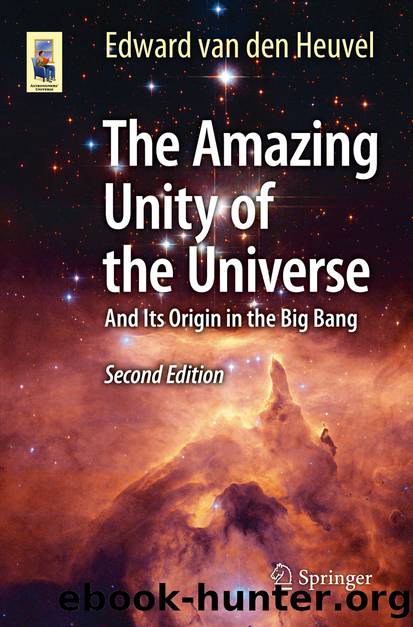The Amazing Unity of the Universe by Edward van den Heuvel

Author:Edward van den Heuvel
Language: eng
Format: epub
Publisher: Springer International Publishing, Cham
The discovery of the cosmic microwave background radiation has transformed cosmology from a speculative theoretical science into a quantitative observational science, based on solid observational facts. Prior to this, physicists often mockingly repeated the statement “Cosmologists are often in error but never in doubt” of Russian theoretical physicist Lev Landau. The discovery of the cosmic microwave background radiation has completely changed this situation. In the first place, the existence of this radiation shows that the universe really originated in a hot Big Bang. In the second place, the precise measurement of the temperature and intensity of the radiation allows one to reconstruct—by simple computation—the entire history of the universe back to one billionth of a second after the Big Bang, by just using presently well-known physics. One of the most amazing characteristics of the cosmic microwave background radiation is its s trength. Already with a modest radio telescope it can be measured. For people that still receive their TV broadcasts with an antenna on the roof (that is: not through a cable), about 1 % of the “snow” on their TV screens is due to the photons of the cosmic microwave background radiation. So, they can directly see the Big Bang on their TV screen! The number of these photons in the universe is extremely large: about one billion per nuclear particle (proton and neutron), just as Gamow and his collaborators Alpher and Herman had predicted in 1949. The equivalent energy of these one billion photons is today much smaller than the equivalent energy of the mass of a proton or neutron: about one million electron-volts against 938 million electron-volts. But this was not always the case. When the universe was twice as small as today, the wavelengths of the cosmic microwave photons were twice as short, so the energies of their photons was twice as large as today. This means that when the universe was 938 times smaller than today, the energy of one billion cosmic microwave photons was just as large as the rest-mass energy of a proton or neutron. So, before that time, there was more energy in the cosmic background radiation than in the matter of the atoms and molecules in the universe. Surprisingly, the time at which the energy of the background photons became similar to that of the nucleons, differs very little from the time when the universe became transparent—which was when it was 1100 times smaller than at present. It is not clear whether this is just a coincidence or whether it has a deeper physical meaning. In any case, it is quite amazing. A further key characteristic of the microwave background radiation is its very high degree of isotropy: the distribution of its intensity over the sky is—apart from a Doppler effect of a few hundred km/s, due to the motion of the solar system relative to the mean background of the universe (see Fig. 9.14 and also Chap. 14)—extremely smooth. The local deviations from the mean intensity are less than one hundredth of a per cent (less than 1 in 10,000).
Download
This site does not store any files on its server. We only index and link to content provided by other sites. Please contact the content providers to delete copyright contents if any and email us, we'll remove relevant links or contents immediately.
| Aeronautics & Astronautics | Astronomy |
| Astrophysics & Space Science | Comets, Meteors & Asteroids |
| Cosmology | Mars |
| Solar System | Star-Gazing |
| Telescopes | UFOs |
Tools of Titans by Timothy Ferriss(8308)
Turbulence by E. J. Noyes(7983)
Secrets of Antigravity Propulsion: Tesla, UFOs, and Classified Aerospace Technology by Ph.D. Paul A. Laviolette(5336)
Astrophysics for People in a Hurry by Neil DeGrasse Tyson(5152)
Room 212 by Kate Stewart(5073)
Design of Trajectory Optimization Approach for Space Maneuver Vehicle Skip Entry Problems by Runqi Chai & Al Savvaris & Antonios Tsourdos & Senchun Chai(5040)
Pale Blue Dot by Carl Sagan(4960)
The David Icke Guide to the Global Conspiracy (and how to end it) by David Icke(4658)
A Journey Through Divination and Astronomy by Publishing Pottermore(4364)
Goodbye Paradise(3766)
Apollo 8 by Jeffrey Kluger(3672)
COSMOS by Carl Sagan(3592)
The Five People You Meet in Heaven by Mitch Albom(3522)
Losing the Nobel Prize by Brian Keating(3521)
How to Read Water: Clues and Patterns from Puddles to the Sea (Natural Navigation) by Tristan Gooley(3434)
Brief Answers to the Big Questions by Stephen Hawking(3394)
How to Read Nature by Tristan Gooley(3294)
The Order of Time by Carlo Rovelli(3164)
A Brief History of Time by Stephen Hawking(2994)
